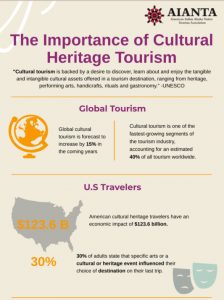
The Importance of Cultural Heritage Tourism
(Click on image to see larger view)
The Importance of Cultural Heritage Tourism
“Cultural tourism is backed by a desire to discover, learn about and enjoy the tangible and intangible cultural assets offered in a tourism destination, ranging from heritage, performing arts, handicrafts, rituals and gastronomy.” -UNESCO
Global Tourism
Global cultural tourism is forecast to increase by 15% in the coming years
Cultural tourism is one of the fastest-growing segments of the tourism industry, accounting for an estimated 40% of all tourism worldwide.
U.S Travelers
American cultural heritage travelers have an economic impact of $123.6 billion.
30% of adults state that specific arts or a cultural or heritage event influenced their choice of destination on their last trip.
Cultural Tourism Spending
Rural arts organizations attract more outside visitors than urban arts organizations (31% vs 14%). These visitors spend money on admissions, parking, dining, etc., contributing directly to local economies.
49% of cultural travelers will pay more for lodging that has a distinctive cultural or heritage component (historic building, local art or decor, architecture, etc.)
Types of Cultural Heritage Tourism
- Culinary tourism, food sovereignty
- National & regional parks, eco-tourism, wildlife tourism
- Sports, games & other athletic events
- Museums. libraries & cultural centers
- Annual festivals, powwows, major events
- Historic sites & commemorations
- Rivers, trails & conservation areas
- Hogans, earth lodges, longhouses, clan houses
- Agritourism
- Performing arts & storytelling
Economic Benefits of Cultural Heritage Tourism
- Injects new money into the economy, boosting businesses and tax revenues
- Creates new jobs
- Funds new businesses, events and attractions, helping diversify the local economy
- Supports small businesses, including artists, local guides, educators
- Helps increase a customer base for local businesses
- Promotes the active preservation and protection of important local resources
- Allows tribes and indigenous communities to define and tell their own stories
Sources:
MyTravel Resources.com
The Goss Agency Inc.
UNESCO
Mandala Research
NEA: Rural Arts, Design & Innovation in America Study
